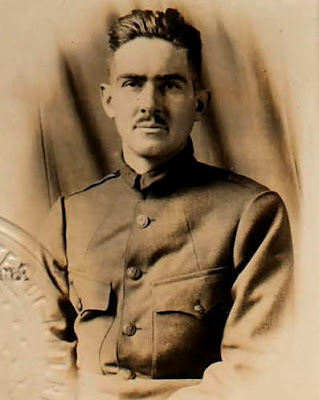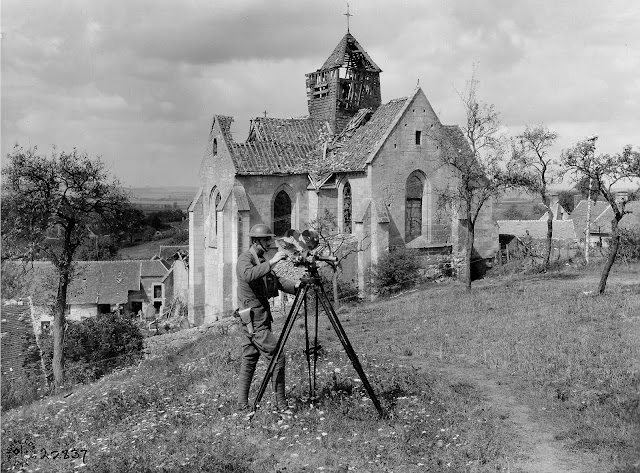 |
Ernest B. Schoedsack (1919) when he was making movies in Poland
|
Best remembered as co-director of the 1933 classic
King Kong, Ernest B. Schoedsack was a pioneering documentary film maker who was one of the first cameramen to take his movie camera into the Thai jungle and covered the nomadic tribes of Iran. His name on the Hollywood Walk of Fame testifies to his extraordinary skills as a film director, producer and cinematographer.
Adventure Story
Schoedsack's life and career has all the makings of an adventure story. Born in Council Bluffs, Iowa, on June 8, 1893, Schoedsack ran away from home at the age of twelve and headed for California. By the time he was seventeen he was working as a cameraman for the Mack Sennett studio. During World War I Schoedsack shot numerous comedies for Mack Sennett, and he also was listed as cinematographer for the Mabel Normand Film Company. When in 1917 America declared war on Germany, Schoedsack enlisted in the Photographic Division of the Signal Corps and was sent to France.
Most of Schoedsack's biographies only have a few words on his film work during the First World War. Apart from Kevin Brownlow's excellent research - he interviewed Schoedsack on his World War I experiences - not much is known about this extraordinary episode in his film career. As is shown in his
World War I Registration Card, Schoedsack was very much interested in the military. From 1915 he was a non-commissioned officer for the National Coast Guard in California. Initially he expected to be sent to the U.S. Coast Guard but there simply wasn't any call for anti-aircraft. When he learned about the new Signal Corps Photographic Division, which was set up to cover the Great War, Schoedsack soon applied for a position. After a brief stint as an instructor at the Columbia School of Military Cinematography Schoedsack was sent to France.
Sailing for France
The
shipping records of the American Expeditionary Force show Schoedsack sailed on the SS
Covington from Hoboken, New Jersey, on June 15, 1918. He was listed as a private soldier, assigned to the U.S. Signal Corps Photographic Division. Schoedsack at first was assigned to the Signal Corps photographic laboratory near Paris. Shortly before his death, Schoedsack recalled his experiences in an interview with Kevin Brownlow:
"We finally reached Paris, and were taken off to Vincennes. The Signal Corps occupied the Pathé chateau, and they had a laboratory and cutting rooms on the fourth floor of the Pathé factory. The other floors were being used as a gas mask factory. The gentleman in command was a very nice old bloke. He had been an optometrist up in Oakland. He was a reservist in the National Guard, and they had to give him a job someplace. So, optometrist pertaining to lenses, lenses to photography - voila! The only officer remotely connected to the picture business was Al Kaufman. The other three executive officers were characters they had no use for anywhere else. The general idea was to stay in Paris and have fun."
Schoedsack was now getting impatient - he wanted to get to the front and film the Great War:
"I complained a lot, and agitated a lot, and finally they said, 'You want to go the front? All right, you can go to the front. A cameraman (Harris Thorpe) pulled out of the combat area and I got my chance. I wanted a light camera. Oh, no. They gave me this damn great Bell and Howell and this great trunk. It weighed a hundred pounds. They needed the light cameras, the Debries, down in Paris, I guess, where all the action was. I had no directive, no passes, no nothing. They didn't even give me a gas mask or a helmet, although I did get a .45 and some ammunition. I got a truck down the combat zone, but an MP stopped me because I had no gas mask or helmet. There were some fresh graves by the side of the road, and one of them had a gas mask and a helmet. The helmet was bashed in on one side, and I remember the name inside was Kelly. Anyway, that got me into the combat zone. There was hardly any activity in the daytime. All the barraging and banging around was at night. Photographically, there was very little you could do."
Cameraman with the 77th Division, A.E.F.
In his interview with Kevin Brownlow Schoedsack did not mention when he was sent to the front but thanks to research by Harry B. Kidd we are now able to reconstruct parts of his film work during World War I and identify some of the movie scenes that he shot while he was in France. On August 25, 1918, Schoedsack's picture was taken in the destroyed village of Mareuil-en-Dôle. This was in the Aisne region, near Château-Thierry. The picture shows Schoedsack cranking a Bell & Howell movie camera among the ruins of a church. The captions mentions he was a private soldier with the Photo Unit of the 77th Division of the American Expeditonary Force (A.E.F.).
 |
Ernest B. Schoedsack at the front in France, during the afttermath of the battle at Château-Thierry with the 77th Division, A.E.F. Indentification by Harry B. Kidd. Link to Harry's original post on Flickr
|
Bahman Maghsoudlou in his book on the making of Schoedsack's film
Grass (1925) mentions that on his arrival in France Schoedsack was placed at the head of the Photographic Unit of the 77th Division. This would have made him a Lieutenant 2nd Class, commanding a team of still and movie photographers. Schoedsack indeed stayed with the 77th Division until the end of the First World War, and he must have recorded many film scenes for this American Division that are now in the National Archives in Washington, D.C., notably "Occupation of the Baccarat Sector" (111-H-1300), "Oise-Aisne Operations" (111-H-1358) and "Meuse-Argonne Offensive" (111-H-1417). But the contemporary records do not produce any evidence that Schoedsack was commissioned as a photographic officer. For example on October 23, 1918, Schoedsack went into a plane and filmed the German lines above the Argonne frontline sector that had just been captured from the enemy. Thanks to research by Harry B. Kidd, the
production records have been retrieved. These documents show Schoedsack was a private soldier when recording these scenes just a couple of weeks before the end of World War I.
After the Great War
Schoedsack was discharged from the American Expeditionary Force in February 1919, but he did not immediately go back to the United States. After the Armistice he joined the American Red Cross and worked on behalf of Polish war relief, helping thousand of Poles escape the Russian occupied territories. Schoedsack at this time also met his lifelong friend and fellow film maker, Merian C. Cooper who, like Schoedsack, was a fervent anti-Bolshevik and also an aspiring film director. Together they filmed the war between Poland and Russia. Shortly afterwards, Schoedsack also covered the war between Greece and Turkey for the American newsreels.
 |
Ernest Schoedsack, filming a Polish wedding dance, 1920. From the collection of the Library of Congress
|
During World War II Schoedsack served in the Air Force. While testing equipment in a tank at Edwards Air Force Base, a shell exploded nearby and his head hit the bottom of the tank turret, detaching the eye retina. Subsequent operations couldn't repair the damage and Schoedsack was virtually blind for the last 35 years of his life.
Ernest Beaumont Schoedsack died on December 23, 1979. He was buried at Westwood Village Memorial Park Cemetery in Los Angeles.
With special thanks to Harry Kidd for his research and input on this weblog











